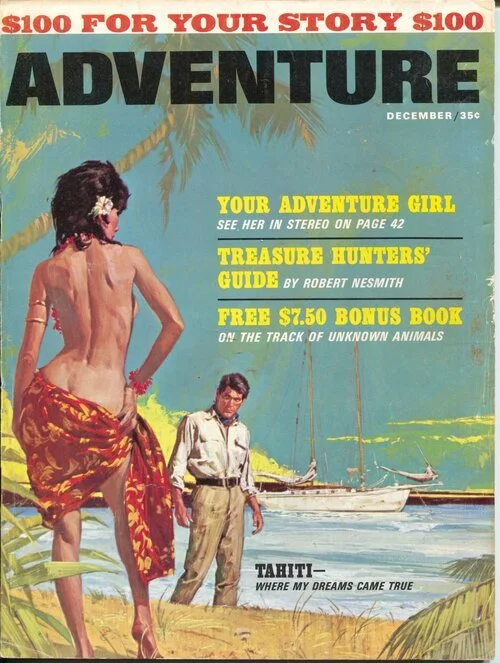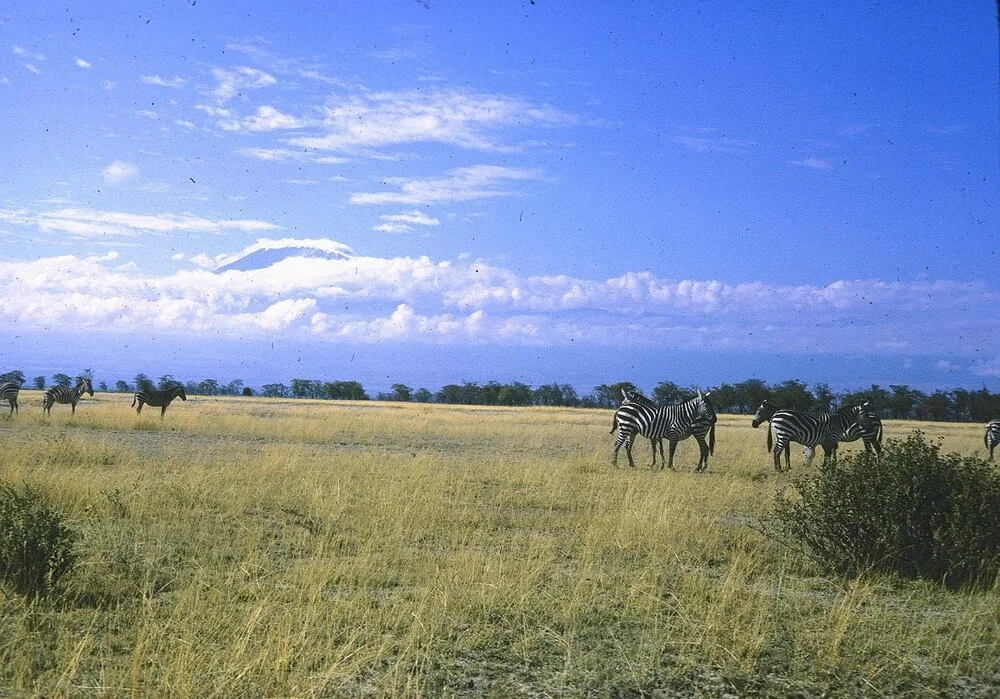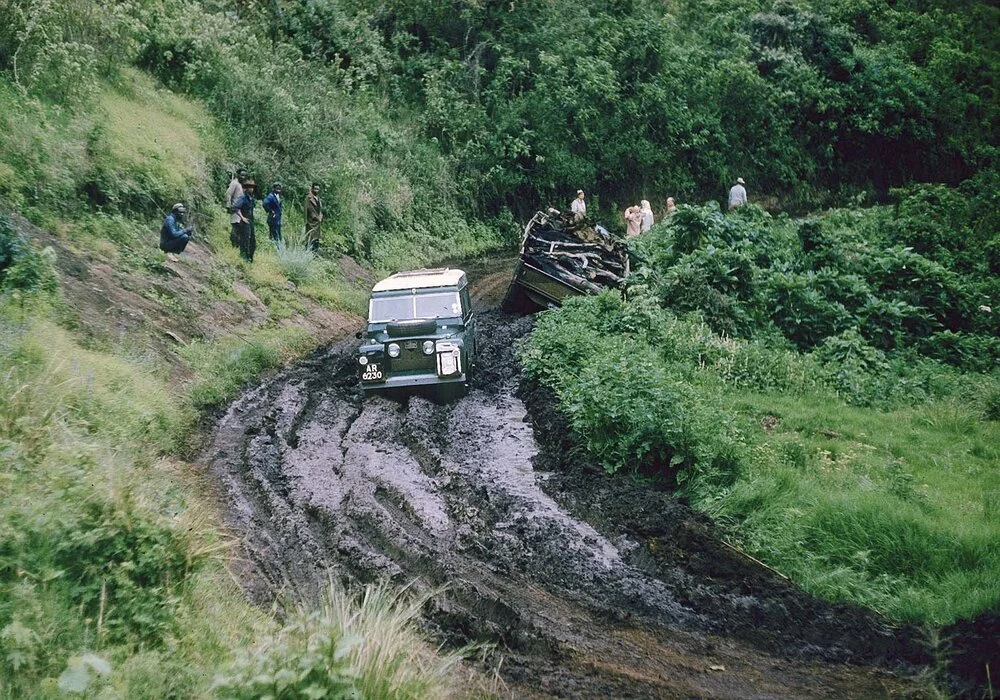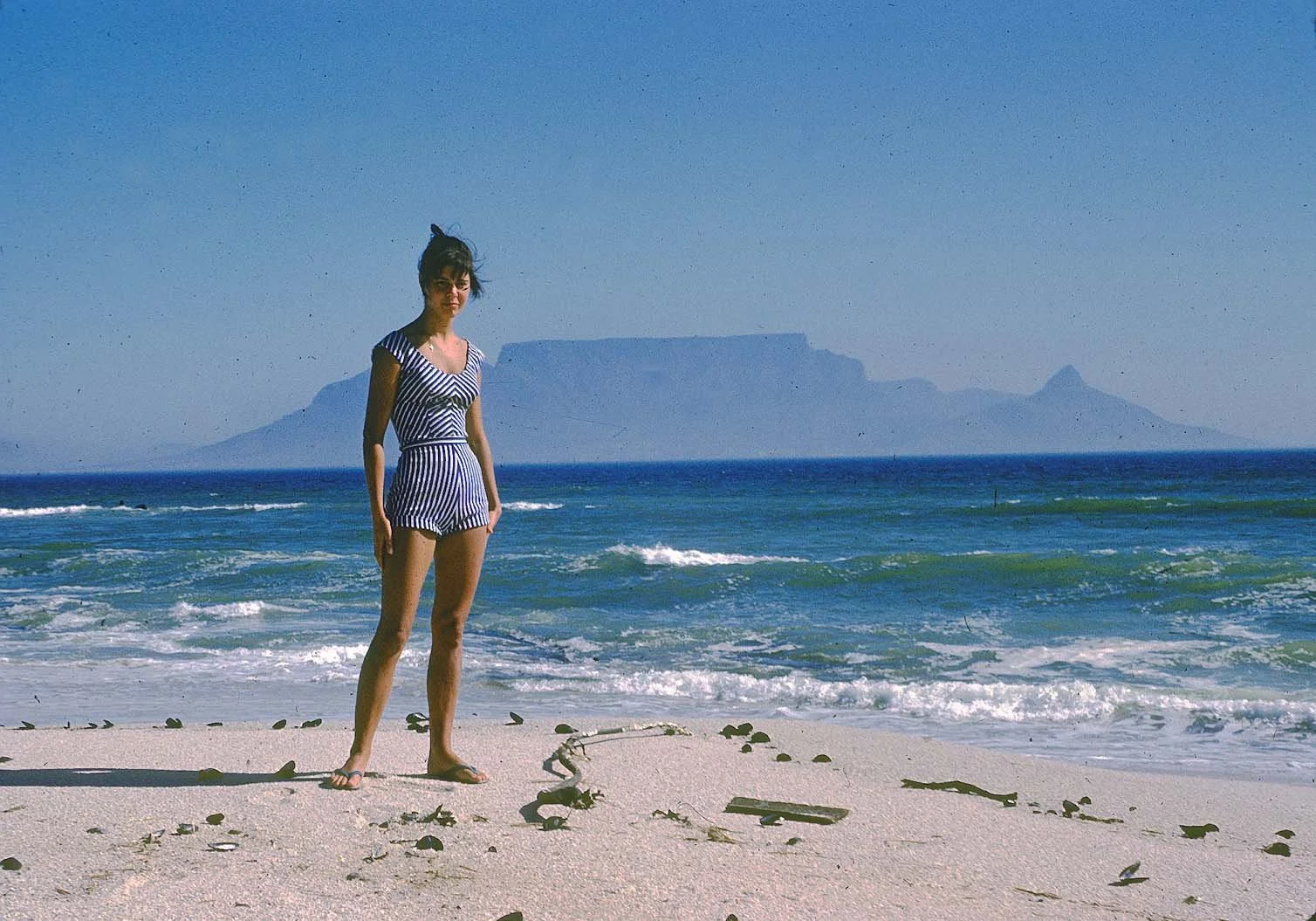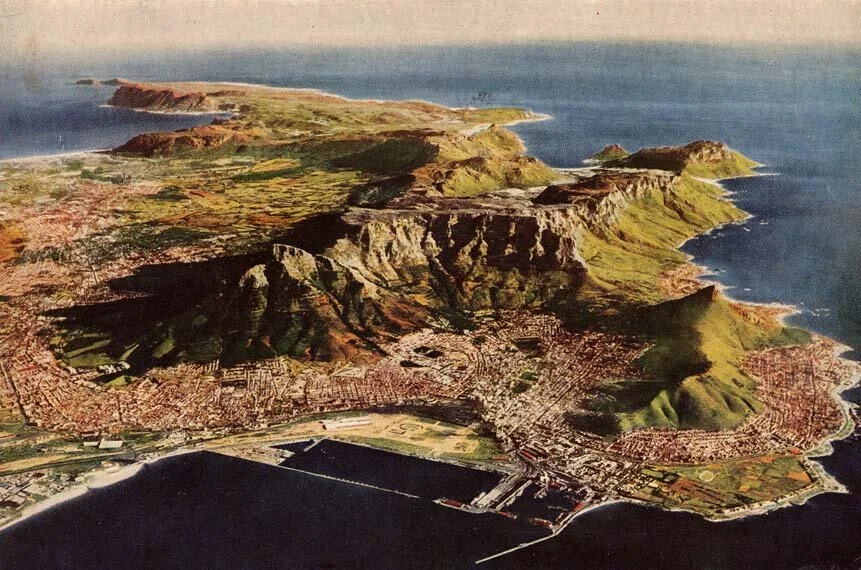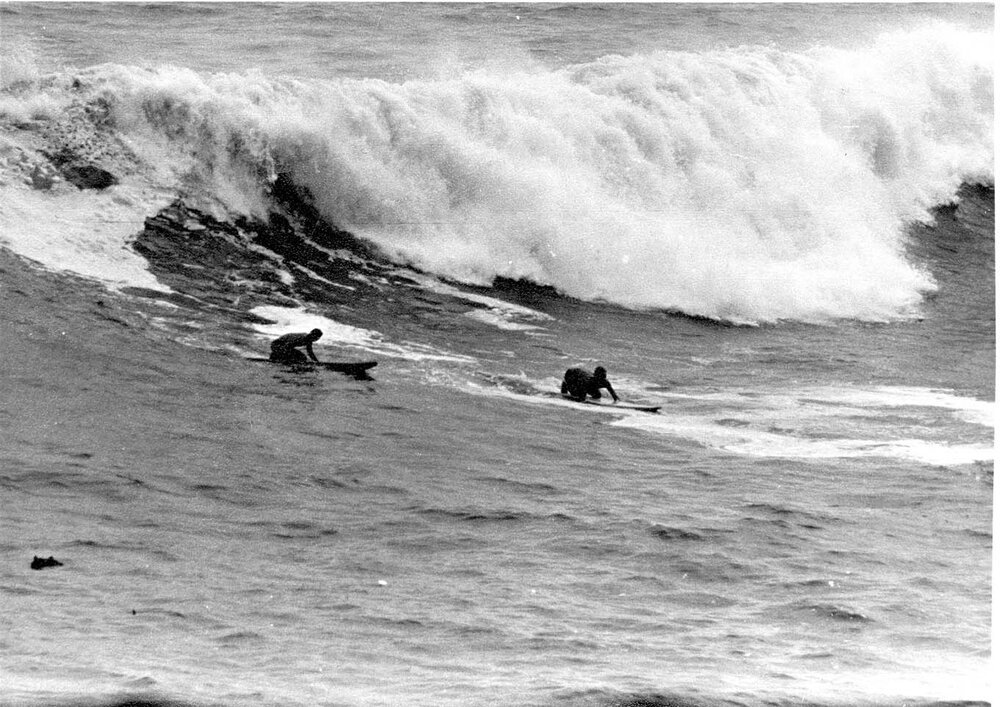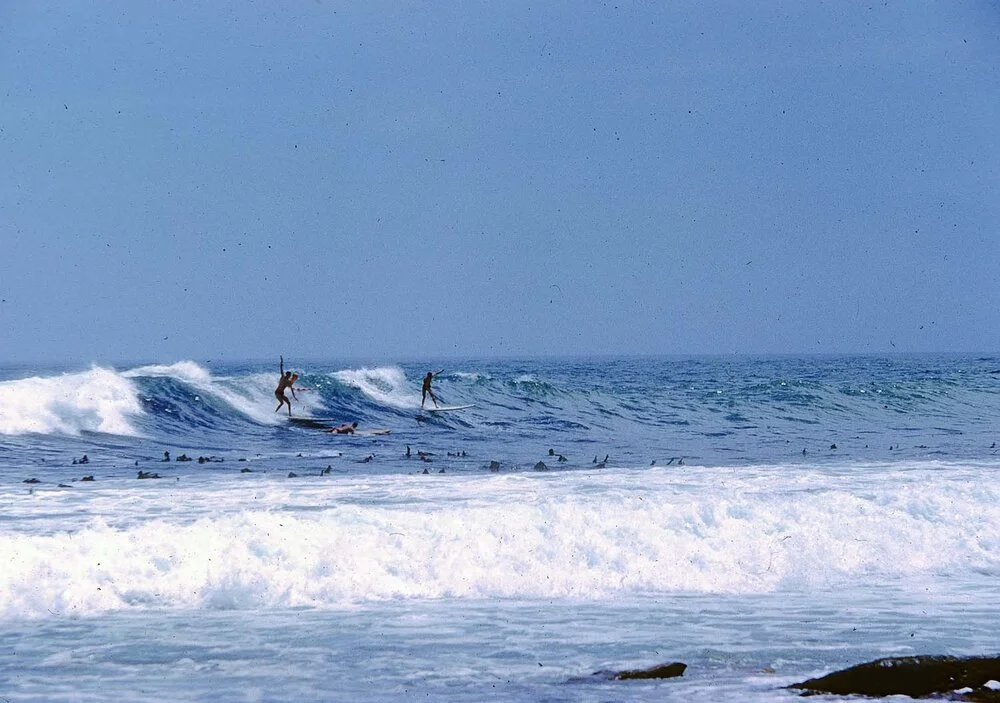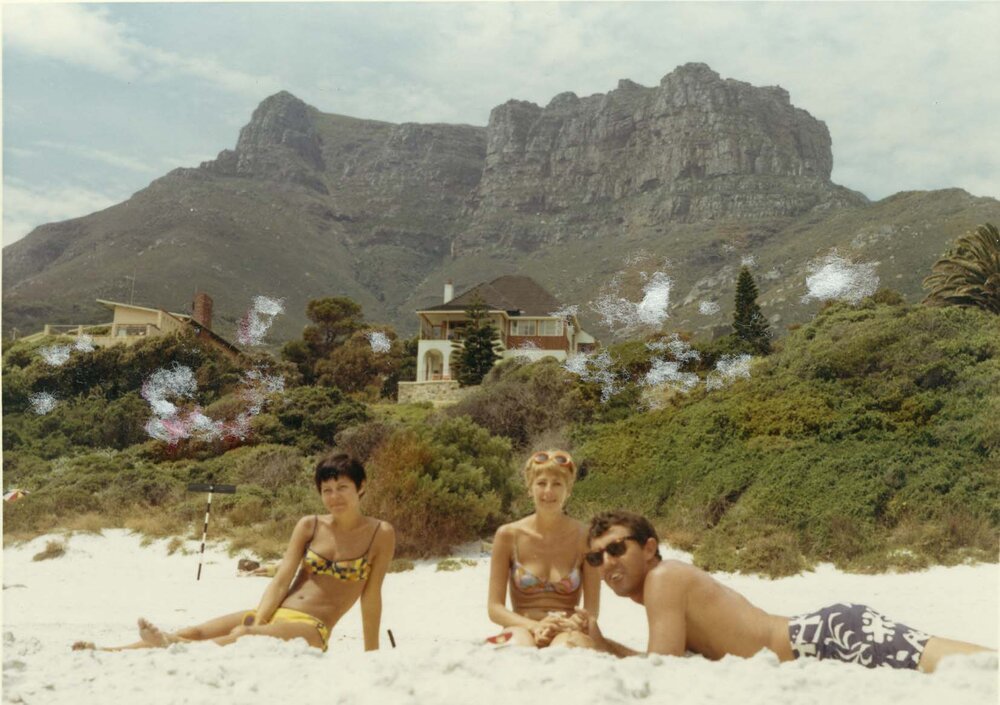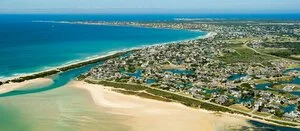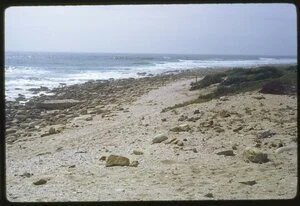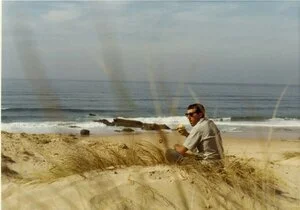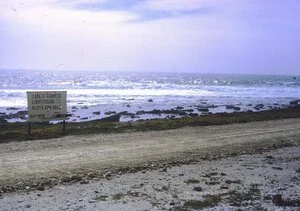“Hey! I’m in Africa.” Metz with friends in deepest, darkest Africa and one of the many many children he fathered during his three-year circumcision… sorry circumnavigation of the globe from 1958 to 1960. Just kidding. Colors courtesy Kodachrome.
Dick Metz is the Forrest Gump of the surfing world. A talented, fast runner when he was younger, yes, but more than that. Just as the fictional Forrest Gump was always on the edge of history, effecting things - from the Have a Happy Day smiley face to Elvis and John F Kennedy and John Lennon and Richard Nixon - the reality of Dick Metz is he was and is still an important but lesser-known player in the dawn of the surf industrial complex from the mid 20th Century and well into the 21st.
Metz has been on earth for quite some time and he has seen a lot of it. Born in 1929 (!) in Laguna Beach, Dick Metz's life is a long arc that goes back to him eating sand on the beach in Laguna with Shirley Temple. A teenager during World War 2 watching the horizon for the Japanese Navy, he was one of the Happy Few surfing in California and Hawaii in the 1950s, enjoying a Secret Thrill. When surfing went public, Dick was the catalyst between Hobie Alter and Grubby Clark futzing with foam blanks and he was in the ear of fabric mogul Walter Hoffman as he was laying down the foundation for surf wear - for surfers and squares.
Dick was the right hand man to Hobie Alter selling surfboards and clothing from Dana Point to Waikiki - and later Hobie Cats. In the 1960s, living la dolce vita in Hawaii, Metz teamed up with Dave Rochlen to produce and sell Jams surf trunks. Metz was also a catalyst in the morphing of the Hobie shop into the Lightning Bolt shop, working with Gerry Lopez and Jack Shipley.
The Forrest Gump of surfing, Metz lit the fuse in the sales of surfboards and clothing and retail stores that ignited in the Roaring 80 and 90s when surfing went public and surf companies made gazillions.
Metz holding court at the Surfing Heritage and Cultural Center.
Metz’ involvement goes right up to the present as the founder of the Surfing Heritage and Cultural Center in San Clemente - the Library of the Alexandrian Greeks for surf culture. A lot of boards and printed material and still and moving images. A lot of history, all under one roof in the back of beyond in San Clemente.
Metz was and is a fun hog and in the middle of the 20th Century he was restless. In the 1950s, Metz got a hankering to see the world, effected, lured and motivated by men’s magazines like Argosy and True, which featured covers of beautiful, topless heathen babes in the South Pacific and around the world.
Restless and ready to Kerouac, in 1958 he sold a ‘50 Ford convertible for $150 to some friends, sold the liquor license for the Surf Liquor Store in Huntington Beach to the people building Disneyland and sold everything - including his TV - to finance his travel jones. He came out of all that wheeling and dealing with 1958$2100 - the equivalent of $18,900 in 2021 dollars.
In Birth of the Endless Summer, Metz claims he hit the road motivated by five needs and wants:
1 See naked girls in Tahiti
2 Surf in Australia
3 See wild animals and wild tribes in Africa
4 Go to the Olympic Games in Rome in 1960
5 Run with the bulls in Pamplona Spain
All noble goals, but the truth is, Metz wanted to visit countries where the women were - shall we say - not as sexually repressed as American women in the 1950s.
Hint hint, nudge nudge, wink wink.
Metz and friend being social in the Society Islands. Again, the sharpness and color of that color film in the 1950s!
So he split, leaving Laguna Beach during a time before passenger jets, when getting around the world required creativity and risk. For starters he hitchhiked and caught trains through Mexico to the Panama Canal, where he paid $80 - the equivalent of $854 now but still a bargain - to jump aboard a French freighter taking French Foreign Legionnaires to Vietnam.
Metz was a lover not a fighter and he got off - so to speak - in Tahiti where his True and Argosy dreams came true (ask him about the topless girl slurping on the fish head).
And that was how it went for three years: Hopping freighters, seeing the world, pleasure and perils, the good, bad and ugly of the earth through the South Pacific, Australia, Indonesia, Asia, India and then another steamer to Africa.
[An epic three-year-tour and adventure, one chapter of a long life which this reviewer tried to squeeze into one book, but it didn’t fit. Not even close. See below.]
Metz and two Belgian Malinois watchdogs who both fell victim to a stealth leopard near Kilimanjaro.Which, in part, lead Dick to Cape Town and eventually Cape Saint Francis.
In Africa, Metz encountered wild animals that wanted to eat his body and charmed wild tribesmen who were killing white people. Staying at a farm in Kilimanjaro, Metz woke up to find a leopard had scaled a wall, climbed through a window and killed and ate two Belgian Malinois dogs without making a sound. He had other close calls with wildlife, and this was a time when the Kikuyu and other African tribes were rising up against white settlers harshly.
How harshly? More harshly than I hope you can imagine.
Kind of like T.E. Lawrence wandering around Arabia on foot before World War I, Dick was a different sort of white man: scruffy and wearing huarache sandals made of old tires. The spear-toting tribesmen had their Africanized versions of huaraches, and that is one reason they didn’t barbeque Metz - one of many yarns he raconteurs in Birth of the Endless Summer.
HEY! I’M IN AFRICA! A FEW OF DICK’S AFRICA PHOTOS.
The Dark Continent was still wild in the late 1950s. Metz wanted to see Victoria Falls and hitched a ride in a Volvo wagon with a dude who needed company and a co-pilot. They arrived at Victoria Falls in the middle of the night to find a couple of fires and shaggy huts. Metz didn’t want to leave the car. So they pushed on to Cape Town - 1200 miles in a straight line from Victoria Falls, but Africa at that time was far from a straight line.
Patty - as beautiful and exotic as Table Rock.
Metz was jazzed to find Cape Town was very similar to Laguna - rocky beaches, clean water, decent surf. He laughed at the horrid surfboard created by John Whitmore, who was offended and then intrigued by this scruffy dude in huarache sandals who knew all about California and Hawaii and surfing. They became friends, and Dick fell in love with Patty - a local lass as beautiful as Table Mountain.
CAPE TOWN AND THE 50S SURF SCENE
And from all of that, fate pointed Dick toward Cape Saint Francis, a long sandy point that had oodles of potential - which Dick saw and took mental notes
Metz pushed on through Africa, the Nile, Egypt, Europe: Eating, drinking and being merry. He witnessed Cassius Clay box at the 1960 Olympics and made it back to Laguna Beach three years after he left with endless photos and stories. He was debriefed by the Dana Point Mafia - including Bruce Brown, a surfer and filmmaker from the Golden Era of Surfing in the 1950s, who was planning an epic, around-the-world surf adventure.
CAPE SAINT FRANCIS GALLERY CIRCA 1959
Around 1963 Bruce Brown wanted to use a surf movie as a medium with a message: “Real surfers don’t break into song in front of their chicks!” A surfer and film maker in the 1950s, Brown was somewhat appalled by the “waxploitation” of surfing which started with Gidget in 1959 and then Ride the Wild Surf, the Beach Boys, Jan and Dean and then those Frankie and Annette movies.
As corny as the Frankie and Annette waxploitation Beach Party movies were, Eric von Zipper is a classic - a funnyman right up there with Turtle, Mick the Masochist and Spicoli.
There was a great deal of surfers breaking into their songs in front of their chicks - and other appallances to the sensibilities of guys like Brown who had started surfing in the Golden Years of the 1950s. Hollywood was getting it wrong and Brown wanted to set it right, so he set out to make an around the world surf adventure to show that Eric von Zipper was full of kukai: Them surfers weren’t beach bums or hoodlums, and that surfing was a grand adventure.
CRASHERS!!!! The Dana Point Mafia, including from left: Ronald Patterson, Corky Carroll, Dick Metz (rear), Mickey Muñoz (front), don't know, Phil Edwards, Bosco Burns and their respective molls, wives and girlfriends at the time - dressed for excess.
Dick gave the back story to this: “Greg Noll threw a big party for the opening of his surfboard factory and shop in Hermosa Beach - but neglected to tell us down south. The second mistake he made was to appoint Hevs McClelland as the MC. Hevs told us, so we all dressed up like that, hired two busses and left Dana Point around 10 or 11 in the morning. We hit every bar between Dana Point and Hermosa and by the time we got to the party we were shit-faced. There was a table loaded with potato salad and me and Mike Stange got in a fight and wrecked it. We trashed the place. Greg Noll was usually the guy instigating that sort of chaos. He never forgave us. Fun times!” (Thanks to Barry Haun at the SHACC for the IDs.)
Metz told Bruce Brown about all he had seen and experienced and photographed in Tahiti and Australia and South Africa. Brown told two friends and he set off with Mike Hynson and Robert August: slick-back groomed and wearing suits and looking more like Mormon Missionaries than beach bums.
Brown and team zigged way down to South Africa, and there they scored absolutely perfect, offshore, four-foot-plus Cape Saint Francis. Endless Summer shook up the world - surfers and squares - and Brown’s project became the most successful documentary up to that time.
All of this is a long story which is detailed visually and narratively in Birth of The Endless Summer. Richard Yelland’s raconteurmentary (raconteurary?) covers the genesis of surf culture/business in the first half of the 20th Century using Dick’s colorful, sharp Kodachrooooome which brings out the nice bright colors, brings out the greens of Africa. Plus archival footage, photos and interviews with the likes of Mike and Robert, Kelly Slater, Walter Hoffman, Steve Pezman, Malibu’s own Allen Sarlo and a lot of South Africans.
Trailer for Birth of the Endless Summer.
BOTES retraces Dick’s zig-zagging adventure in the late 1950s, and updates it now, as Metz returns to South Africa to see his old friends and all that has changed along there in over 60 years: “I originally knew Dick's story because I learned about it when I worked with him on 12 Miles North,” Richard Yelland said, referring to his 2012 documentary about African American surfer Nick Gabaldon. “I started making this film right after Bruce Brown passed away in 2017. I saw the tributes coming in from every generation of surfer. I knew this story connected everyone. And it dawned on me that if Dick's story was indeed the "untold story" it would possibly be the most interesting version of The Endless Summer. After a long brunch with Dick at neighboring Harbor House diner in Dana Point, all of my dreams for this story were true.
“Now here we are five years later - and it was super satisfying to see Mike Hyson at our cinema premiere on 6/14 at La Paloma. I like to think he was stoked not only because it's a good movie but because this film takes this period of history out of the shadow of Bruce and The Endless Summer.”
There is Cape St Francis DNA right up to the present. Look at KellyLand - the Kelly Slater WaveCo artificial wave at Surf Ranch - and Cape St Francis side by side. The perfect wave. Clever bastards have captured lightning in a bottle in Lemoore of all places - the land of meth and methane. And the perfection of that wave was set in motion in the late 1950s, when Dick Metz bumped into Cape Saint Francis while dodging leopards and spears in deepest, darkest Africa.
If you’re the sort of person who gets weepy when you hear the theme song to The Endless Summer you will love Birth of the Endless Summer.
How do I know all this? Around 2019 the SHACC asked me to produce a book about Dick Metz: Try to fit the whole 1929 - 2019 arc on paper inside two covers. They handed me a mostly excellent, 90,000 word interview that needed polishing and finishing and stacks of quality images that went back to the 1930s.
The materials were great but I had to tell them that it wouldn't all fit in a book anything short of the four-volume History of the English Speaking Peoples. With a book you're always cutting material and killing your babies. I suggested they do what I call a "webiography."
Put it all online with lots of links and visuals and moving images and then you wouldn't have to cut anything. It would all fit. To demonstrate the concept I did one chapter which you can see online. This is Dick Metz explaining why he wanted to go around the world in the late 50s and it focuses on his time in Africa.
You can see that here with all of Dick’s photos and more backstory to Endless Summer and Cape Saint Francis here:
https://www.benmarcusrules.com/dick-metz-hey-im-in-africa-excerpt



